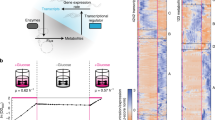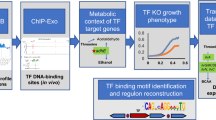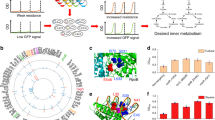Abstract
Although metabolic networks have been reconstructed on a genome scale, the corresponding reconstruction and integration of governing transcriptional regulatory networks has not been fully achieved. Here we reconstruct such an integrated network for amino acid metabolism in Escherichia coli. Analysis of ChIP-chip and gene expression data for the transcription factors ArgR, Lrp and TrpR showed that 19 out of 20 amino acid biosynthetic pathways are either directly or indirectly controlled by these regulators. Classifying the regulated genes into three functional categories of transport, biosynthesis and metabolism leads to the elucidation of regulatory motifs that constitute the integrated network's basic building blocks. The regulatory logic of these motifs was determined on the basis of relationships between transcription factor binding and changes in the amount of transcript in response to exogenous amino acids. Remarkably, the resulting logic shows how amino acids are differentiated as signaling and nutrient molecules, revealing the overarching regulatory principles of the amino acid stimulon.
This is a preview of subscription content, access via your institution
Access options
Subscribe to this journal
Receive 12 print issues and online access
$259.00 per year
only $21.58 per issue
Buy this article
- Purchase on Springer Link
- Instant access to full article PDF
Prices may be subject to local taxes which are calculated during checkout





Similar content being viewed by others
References
Joyce, A.R. & Palsson, B.Ø. The model organism as a system: integrating 'omics' data sets. Nat. Rev. Mol. Cell Biol. 7, 198–210 (2006).
Covert, M.W., Knight, E.M., Reed, J.L., Herrgard, M.J. & Palsson, B.Ø. Integrating high-throughput and computational data elucidates bacterial networks. Nature 429, 92–96 (2004).
Cho, B.K., Barrett, C.L., Knight, E.M., Park, Y.S. & Palsson, B.Ø. Genome-scale reconstruction of the Lrp regulatory network in Escherichia coli. Proc. Natl. Acad. Sci. USA 105, 19462–19467 (2008).
Alon, U. Network motifs: theory and experimental approaches. Nat. Rev. Genet. 8, 450–461 (2007).
Hershberg, R. & Margalit, H. Co-evolution of transcription factors and their targets depends on mode of regulation. Genome Biol. 7, R62 (2006).
Charlier, D. et al. Arginine regulon of Escherichia coli K-12. A study of repressor-operator interactions and of in vitro binding affinities versus in vivo repression. J. Mol. Biol. 226, 367–386 (1992).
Yang, J. et al. In vivo and in vitro studies of TrpR-DNA interactions. J. Mol. Biol. 258, 37–52 (1996).
Pittard, J., Camakaris, H. & Yang, J. The TyrR regulon. Mol. Microbiol. 55, 16–26 (2005).
Tani, T.H., Khodursky, A., Blumenthal, R.M., Brown, P.O. & Matthews, R.G. Adaptation to famine: a family of stationary-phase genes revealed by microarray analysis. Proc. Natl. Acad. Sci. USA 99, 13471–13476 (2002).
Levin, J.Z. et al. Comprehensive comparative analysis of strand-specific RNA sequencing methods. Nat. Methods 7, 709–715 (2010).
Faith, J.J. et al. Large-scale mapping and validation of Escherichia coli transcriptional regulation from a compendium of expression profiles. PLoS Biol. 5, e8 (2007).
Calvo, J.M. & Matthews, R.G. The leucine-responsive regulatory protein, a global regulator of metabolism in Escherichia coli. Microbiol. Rev. 58, 466–490 (1994).
Cho, B.K., Knight, E.M. & Palsson, B.Ø. PCR-based tandem epitope tagging system for Escherichia coli genome engineering. Biotechniques 40, 67–72 (2006).
Cho, B.K. et al. The transcription unit architecture of the Escherichia coli genome. Nat. Biotechnol. 27, 1043–1049 (2009).
Gama-Castro, S. et al. RegulonDB version 7.0: transcriptional regulation of Escherichia coli K-12 integrated within genetic sensory response units (Gensor Units). Nucleic Acids Res. 39, D98–D105 (2011).
Keseler, I.M. et al. EcoCyc: a comprehensive view of Escherichia coli biology. Nucleic Acids Res. 37, D464–D470 (2009).
Caldara, M., Charlier, D. & Cunin, R. The arginine regulon of Escherichia coli: whole-system transcriptome analysis discovers new genes and provides an integrated view of arginine regulation. Microbiology 152, 3343–3354 (2006).
Caldara, M., Minh, P.N., Bostoen, S., Massant, J. & Charlier, D. ArgR-dependent repression of arginine and histidine transport genes in Escherichia coli K-12. J. Mol. Biol. 373, 251–267 (2007).
Jeeves, M., Evans, P.D., Parslow, R.A., Jaseja, M. & Hyde, E.I. Studies of the Escherichia coli Trp repressor binding to its five operators and to variant operator sequences. Eur. J. Biochem. 265, 919–928 (1999).
Van Duyne, G.D., Ghosh, G., Maas, W.K. & Sigler, P.B. Structure of the oligomerization and L-arginine binding domain of the arginine repressor of Escherichia coli. J. Mol. Biol. 256, 377–391 (1996).
Zhang, R.G. et al. The crystal structure of trp aporepressor at 1.8 A shows how binding tryptophan enhances DNA affinity. Nature 327, 591–597 (1987).
Maas, W.K. Studies on the mechanism of repression of arginine biosynthesis in Escherichia coli: I. dominance of repressibility in diploids. J. Mol. Biol. 8, 365–370 (1964).
Kiupakis, A.K. & Reitzer, L. ArgR-independent induction and ArgR-dependent superinduction of the astCADBE operon in Escherichia coli. J. Bacteriol. 184, 2940–2950 (2002).
Khodursky, A.B. et al. DNA microarray analysis of gene expression in response to physiological and genetic changes that affect tryptophan metabolism in Escherichia coli. Proc. Natl. Acad. Sci. USA 97, 12170–12175 (2000).
Bennett, B.D. et al. Absolute metabolite concentrations and implied enzyme active site occupancy in Escherichia coli. Nat. Chem. Biol. 5, 593–599 (2009).
Cho, B.K. et al. The PurR regulon in Escherichia coli K-12 MG1655. Nucleic Acids Res. 39, 6456–6464 (2011).
Krishna, S., Semsey, S. & Sneppen, K. Combinatorics of feedback in cellular uptake and metabolism of small molecules. Proc. Natl. Acad. Sci. USA 104, 20815–20819 (2007).
Semsey, S. et al. Genetic regulation of fluxes: iron homeostasis of Escherichia coli. Nucleic Acids Res. 34, 4960–4967 (2006).
Semsey, S., Krishna, S., Sneppen, K. & Adhya, S. Signal integration in the galactose network of Escherichia coli. Mol. Microbiol. 65, 465–476 (2007).
Powell, B.S. et al. Novel proteins of the phosphotransferase system encoded within the rpoN operon of Escherichia coli. Enzyme IIANtr affects growth on organic nitrogen and the conditional lethality of an erats mutant. J. Biol. Chem. 270, 4822–4839 (1995).
Klig, L.S., Oxender, D.L. & Yanofsky, C. Second-site revertants of Escherichia coli trp repressor mutants. Genetics 120, 651–655 (1988).
Cho, B.K., Knight, E.M., Barrett, C.L. & Palsson, B.Ø. Genome-wide analysis of Fis binding in Escherichia coli indicates a causative role for A-/AT-tracts. Genome Res. 18, 900–910 (2008).
Cho, B.K., Knight, E.M. & Palsson, B.Ø. Genomewide identification of protein binding locations using chromatin immunoprecipitation coupled with microarray. Methods Mol. Biol. 439, 131–145 (2008).
Mosteller, F. & Tukey, J.W. Data Analysis and Regression: A Second Course in Statistics (Addison-Wesley Pub. Co., 1977).
Wu, Z. et al. A model-based background adjustment for oligonucleotide expression arrays. J. Am. Stat. Assoc. 99, 909–917 (2004).
Benjamini, Y. & Hochberg, Y. Controlling the false discovery rate: a practical and powerful approach to multiple testing. J. R. Stat. Soc. Ser. B Methodol. 57, 289–300 (1995).
Bailey, T.L. et al. MEME SUITE: tools for motif discovery and searching. Nucleic Acids Res. 37, W202–W208 (2009).
Bailey, T.L., Williams, N., Misleh, C. & Li, W.W. MEME: discovering and analyzing DNA and protein sequence motifs. Nucleic Acids Res. 34, W369–W373 (2006).
Makarova, K.S., Mironov, A.A. & Gelfand, M.S. Conservation of the binding site for the arginine repressor in all bacterial lineages. Genome Biol. 2, RESEARCH0013 (2001).
Acknowledgements
The authors thank M. Abrams and J. Lerman for critical reading of the manuscript. The US National Institutes of Health (through grant GM062791) and the Office of Science–Biological and Environmental Research, US Department of Energy (through grant DE-FOA-0000143) supported this work.
Author information
Authors and Affiliations
Contributions
B.-K.C. and B.Ø.P. conceived the study. B.-K.C. and Y.-S.P. designed and performed ChIP-chip and gene expression experiments. B.-K.C. and S.F. analyzed data with contributions from K.Z. The manuscript was written by B.-K.C., S.F., K.Z. and B.Ø.P.
Corresponding authors
Ethics declarations
Competing interests
The authors declare no competing financial interests.
Supplementary information
Supplementary Text and Figures
Supplementary Results (PDF 1346 kb)
Rights and permissions
About this article
Cite this article
Cho, BK., Federowicz, S., Park, YS. et al. Deciphering the transcriptional regulatory logic of amino acid metabolism. Nat Chem Biol 8, 65–71 (2012). https://doi.org/10.1038/nchembio.710
Received:
Accepted:
Published:
Issue Date:
DOI: https://doi.org/10.1038/nchembio.710
This article is cited by
-
Protein engineering for feedback resistance in 3-deoxy-D-arabino-heptulosonate 7-phosphate synthase
Applied Microbiology and Biotechnology (2022)
-
Advances and prospects in metabolic engineering of Escherichia coli for L-tryptophan production
World Journal of Microbiology and Biotechnology (2022)
-
Microbial application of thermophilic Thermoanaerobacterium species in lignocellulosic biorefinery
Applied Microbiology and Biotechnology (2021)
-
Redefining fundamental concepts of transcription initiation in bacteria
Nature Reviews Genetics (2020)
-
Characterization of the two nonidentical ArgR regulators of Tetragenococcus halophilus and their regulatory effects on arginine metabolism
Applied Microbiology and Biotechnology (2020)



